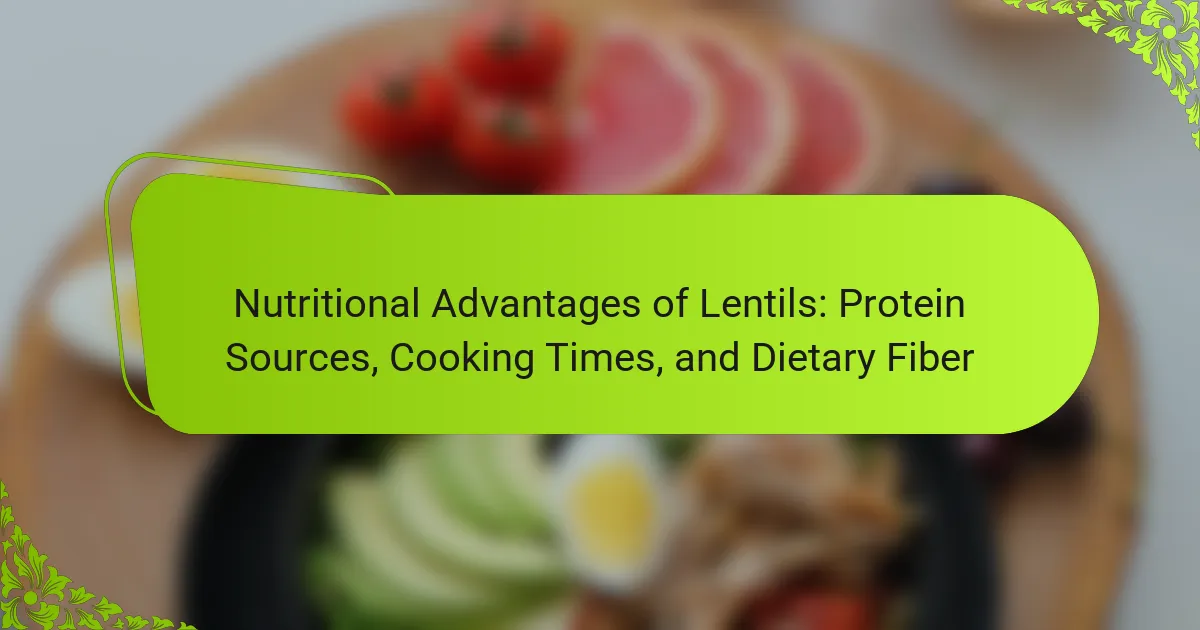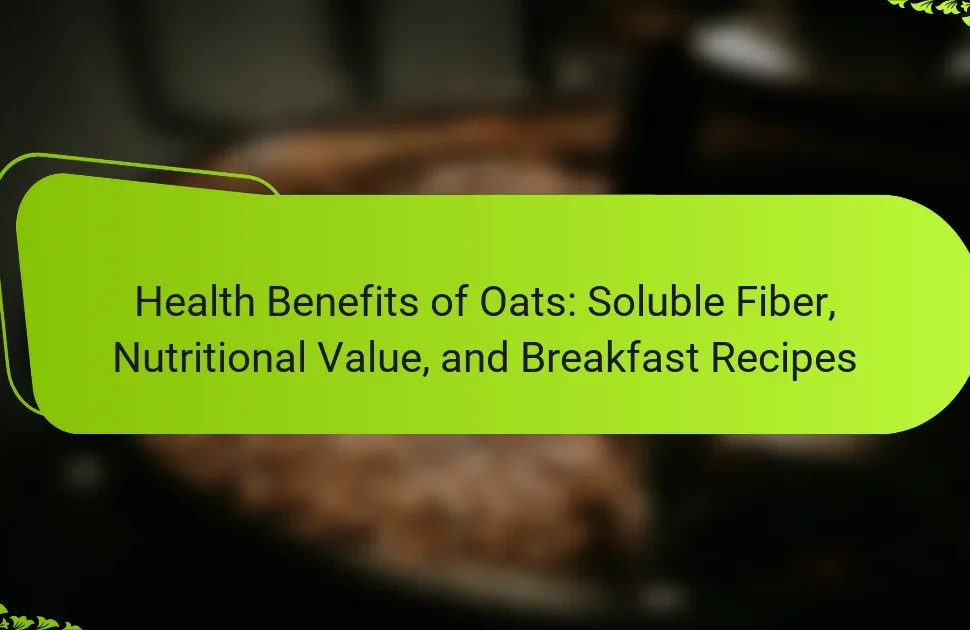
What are the Nutritional Advantages of Lentils?
Lentils provide numerous nutritional advantages. They are an excellent source of plant-based protein, containing about 18 grams per cooked cup. Lentils are also rich in dietary fiber, offering approximately 15.6 grams per cooked cup. This high fiber content aids digestion and promotes gut health. Additionally, lentils are low in fat, with less than 1 gram per serving. They are packed with essential vitamins and minerals, including iron, folate, and magnesium. A cooked cup of lentils provides about 37% of the daily recommended intake of folate. Their complex carbohydrates offer sustained energy without causing spikes in blood sugar levels. Overall, lentils are a nutrient-dense food that supports overall health.
Why are lentils considered a valuable protein source?
Lentils are considered a valuable protein source because they contain approximately 18 grams of protein per cooked cup. This high protein content makes them an excellent option for vegetarians and vegans. Lentils provide all essential amino acids, making them a complete protein when combined with grains. They are also low in fat and high in dietary fiber, which aids in digestion. Additionally, lentils are rich in vitamins and minerals, including iron and folate. Their protein quality is comparable to that of meat, which supports muscle health and repair. Studies show that incorporating lentils into the diet can help meet daily protein needs effectively.
What types of proteins do lentils contain?
Lentils contain several types of proteins, primarily globulins and albumins. Globulins make up about 60% of the protein content in lentils. They are water-insoluble and play a crucial role in plant metabolism. Albumins, on the other hand, account for approximately 20-25% of lentil proteins. They are soluble in water and serve as storage proteins. Lentils also provide essential amino acids, including lysine, which is often limited in other plant sources. This makes lentils a valuable protein source for vegetarians and vegans.
How does the protein content of lentils compare to other sources?
Lentils contain approximately 18 grams of protein per cooked cup. This protein content is higher than many vegetables and grains. For comparison, cooked quinoa has about 8 grams of protein per cup. Brown rice offers around 5 grams of protein per cup. Lentils also provide more protein than most beans, which average between 15 to 17 grams per cooked cup. Additionally, animal sources like chicken breast contain about 43 grams of protein per cooked cup. However, lentils are a valuable plant-based protein source, particularly for vegetarians and vegans. Their protein quality is enhanced by their fiber content, making them a nutritious choice in a balanced diet.
What role do lentils play in dietary fiber intake?
Lentils are a significant source of dietary fiber. They contain approximately 15.6 grams of fiber per cooked cup. This high fiber content contributes to digestive health. Fiber helps regulate bowel movements and prevents constipation. Additionally, it aids in controlling blood sugar levels. Lentils also promote a feeling of fullness, which can assist in weight management. Their soluble fiber can lower cholesterol levels, supporting heart health. Overall, lentils play a vital role in enhancing dietary fiber intake.
What types of dietary fiber are found in lentils?
Lentils contain two main types of dietary fiber: soluble fiber and insoluble fiber. Soluble fiber in lentils helps to regulate blood sugar levels and lower cholesterol. It forms a gel-like substance in the gut, aiding digestion. Insoluble fiber adds bulk to stool and promotes regular bowel movements. This type of fiber is crucial for digestive health. Lentils are particularly high in fiber, with approximately 7.9 grams per 100 grams cooked. This high fiber content supports overall health and wellness.
How does dietary fiber from lentils benefit digestive health?
Dietary fiber from lentils benefits digestive health by promoting regular bowel movements. It adds bulk to the stool, making it easier to pass. This can help prevent constipation. Lentils contain both soluble and insoluble fiber. Soluble fiber can help regulate blood sugar levels. Insoluble fiber aids in maintaining a healthy gut environment. Studies show that a high-fiber diet can reduce the risk of digestive disorders. For example, a study published in the American Journal of Clinical Nutrition found that fiber intake is linked to lower rates of colorectal cancer. This evidence supports the role of lentils in enhancing digestive health.
How do cooking times affect the nutritional value of lentils?
Cooking times significantly affect the nutritional value of lentils. Longer cooking times can lead to nutrient loss, particularly of water-soluble vitamins like B vitamins. Overcooking can also break down proteins and reduce their bioavailability. Conversely, undercooking may result in harder lentils that are less digestible. Studies indicate that cooking lentils for 15 to 30 minutes retains more nutrients compared to longer durations. For instance, a study published in the Journal of Food Science found that cooking lentils for 20 minutes preserved more folate than cooking them for 40 minutes. This highlights the importance of optimal cooking times to maximize the nutritional benefits of lentils.
What are the recommended cooking methods for lentils?
The recommended cooking methods for lentils include boiling, simmering, and pressure cooking. Boiling involves placing lentils in water and cooking them until tender. Simmering is a gentler method, allowing lentils to cook slowly in a covered pot. Pressure cooking significantly reduces cooking time, making it efficient. Each method enhances the lentils’ nutritional profile, retaining their protein and fiber content. Cooking times vary by lentil type; for example, red lentils cook in about 15 minutes, while green lentils may take 30 minutes. These methods ensure that lentils are easily digestible and flavorful.
How does cooking time influence the nutrient retention in lentils?
Cooking time significantly influences nutrient retention in lentils. Longer cooking times can lead to a reduction in certain nutrients, particularly water-soluble vitamins like B vitamins. Studies indicate that cooking lentils for extended periods may decrease their folate content by up to 30%. Conversely, shorter cooking times can help preserve these nutrients, maintaining their overall nutritional value. Optimal cooking time for lentils typically ranges from 15 to 30 minutes, which balances tenderness and nutrient retention effectively.

How can lentils be incorporated into a balanced diet?
Lentils can be incorporated into a balanced diet by adding them to various meals. They serve as a great source of plant-based protein. One cup of cooked lentils provides about 18 grams of protein. This makes them an excellent meat alternative for vegetarians and vegans. Lentils are also high in dietary fiber, with one cup offering around 16 grams. This fiber aids in digestion and promotes satiety.
Including lentils in soups, salads, and stews enhances nutritional value. They can also be blended into dips or spreads, such as lentil hummus. Cooking lentils is quick, typically taking 15-30 minutes, making them convenient for meal prep. Studies show that regular consumption of lentils can improve heart health due to their low cholesterol and high fiber content. Therefore, incorporating lentils into daily meals supports a balanced diet.
What are some popular recipes that feature lentils?
Popular recipes that feature lentils include lentil soup, lentil salad, and lentil curry. Lentil soup is made by simmering lentils with vegetables and spices. This dish is nutritious and filling. Lentil salad combines cooked lentils with fresh vegetables and a dressing. It is often served cold and is a great source of protein. Lentil curry features lentils cooked in a spiced sauce, often served with rice. Each of these recipes highlights lentils’ versatility and nutritional benefits.
How can lentils be used in vegetarian and vegan dishes?
Lentils can be used in various vegetarian and vegan dishes as a primary protein source. They can be cooked in soups, stews, and salads. Lentils add texture and nutrition to veggie burgers and meat alternatives. They can also be blended into dips, such as lentil hummus. Rich in dietary fiber, lentils support digestive health. One cup of cooked lentils provides about 18 grams of protein. This makes them an excellent substitute for meat in many recipes. Lentils are versatile and can be flavored with spices and herbs to enhance their taste.
What are some quick and easy lentil-based meals?
Lentil-based meals can be quick and easy to prepare. Examples include lentil soup, which can be made in under 30 minutes. Another option is a lentil salad, combining cooked lentils with vegetables and dressing. Lentil tacos are also simple, using lentils as a filling with spices. Additionally, lentil curry can be prepared quickly with canned lentils. These meals are nutritious and rich in protein and dietary fiber. Lentils cook relatively fast, especially when using pre-cooked or canned varieties, making them an efficient choice for meals.
What tips can enhance the nutritional benefits of lentils?
Soaking lentils before cooking enhances their nutritional benefits. This process reduces anti-nutrients, improving mineral absorption. Soaked lentils also cook faster, preserving more nutrients. Adding spices like turmeric or cumin boosts antioxidant levels. Combining lentils with vitamin C-rich foods, such as bell peppers, enhances iron absorption. Cooking lentils with broth instead of water adds flavor and nutrients. Using fresh herbs increases the nutritional profile and taste. Lastly, sprouting lentils can increase their vitamin content significantly.
How can combining lentils with other foods improve their nutritional profile?
Combining lentils with other foods can enhance their nutritional profile by providing complementary amino acids. Lentils are rich in protein but lack certain essential amino acids. Pairing lentils with grains, like rice or quinoa, creates a complete protein source. This combination ensures all essential amino acids are present in the meal. Additionally, adding vegetables boosts vitamins and minerals. For instance, pairing lentils with leafy greens increases iron and vitamin C intake. This synergy maximizes nutrient absorption and overall health benefits.
What common mistakes should be avoided when cooking lentils?
Common mistakes to avoid when cooking lentils include not rinsing them before cooking. Rinsing removes dirt and impurities. Another mistake is overcooking lentils, which can lead to mushiness. Cooking times vary by type; brown lentils take about 20-30 minutes, while red lentils cook in 10-15 minutes. Adding salt too early in the cooking process can toughen the lentils. It’s best to add salt towards the end. Not using enough water is also a frequent error. Lentils require a 3:1 water-to-lentil ratio for proper cooking. Lastly, neglecting to soak lentils can lead to longer cooking times, especially for larger varieties. Soaking for a few hours can enhance texture and reduce cooking time.

What are the health benefits associated with consuming lentils?
Consuming lentils offers numerous health benefits. They are an excellent source of plant-based protein, providing about 18 grams per cooked cup. Lentils are rich in dietary fiber, which aids in digestion and helps maintain healthy blood sugar levels. They contain essential nutrients such as iron, folate, and magnesium. These nutrients support energy production and overall metabolic health. Lentils are low in fat and high in antioxidants, contributing to heart health. Research indicates that regular consumption of lentils can reduce the risk of chronic diseases such as diabetes and heart disease. A study published in the Journal of Nutrition found that lentils can improve cholesterol levels and promote a healthy weight.
How do lentils contribute to heart health?
Lentils contribute to heart health by being high in dietary fiber and low in saturated fat. Their fiber content helps lower cholesterol levels. This reduction in cholesterol can decrease the risk of heart disease. Lentils are also rich in potassium, which supports healthy blood pressure. Additionally, they provide essential nutrients like folate and magnesium. Folate is important for reducing homocysteine levels, a risk factor for heart disease. Studies show that regular consumption of lentils can improve cardiovascular health. For instance, a study published in the American Journal of Clinical Nutrition found that legumes, including lentils, are associated with lower heart disease risk.
What specific nutrients in lentils support cardiovascular function?
Lentils contain several specific nutrients that support cardiovascular function. These include dietary fiber, folate, magnesium, and potassium. Dietary fiber helps lower cholesterol levels, which reduces the risk of heart disease. Folate supports the reduction of homocysteine levels, an amino acid linked to increased heart disease risk. Magnesium aids in maintaining normal blood pressure, promoting overall heart health. Potassium helps regulate heart rhythms and can lower blood pressure. Together, these nutrients contribute to improved cardiovascular health.
How can lentils help in managing cholesterol levels?
Lentils can help manage cholesterol levels by providing soluble fiber. Soluble fiber binds to cholesterol in the digestive system. This binding process helps reduce the absorption of cholesterol into the bloodstream. Studies show that a diet high in soluble fiber can lower LDL cholesterol levels. Lentils contain approximately 5-6 grams of fiber per cooked cup. This fiber content contributes to heart health. Regular consumption of lentils can lead to improved cholesterol profiles over time.
What impact do lentils have on weight management?
Lentils aid in weight management due to their high protein and fiber content. Protein promotes satiety, reducing overall calorie intake. Fiber enhances digestion and prolongs feelings of fullness. A study published in the Journal of Nutrition found that incorporating legumes like lentils can lead to weight loss. Participants consuming lentils reported decreased hunger levels. Additionally, lentils have a low glycemic index, which helps stabilize blood sugar levels. This prevents spikes in hunger and cravings. Overall, lentils are a beneficial food choice for effective weight management.
How do the fiber and protein in lentils promote satiety?
Fiber and protein in lentils promote satiety by slowing digestion and enhancing feelings of fullness. Fiber adds bulk to meals, which can increase the feeling of fullness. Lentils contain soluble fiber, which forms a gel-like substance in the stomach. This gel slows down gastric emptying, prolonging the feeling of satisfaction after eating.
Protein also contributes to satiety by stimulating the release of hormones that signal fullness. Lentils are a rich source of plant-based protein, with about 18 grams per cooked cup. Research shows that high-protein meals can reduce hunger and lead to lower calorie intake throughout the day. Together, the fiber and protein in lentils work synergistically to enhance satiety, making them a beneficial food for weight management.
What role do lentils play in a weight-loss diet?
Lentils play a significant role in a weight-loss diet. They are low in calories and high in protein and fiber. A 1-cup serving of cooked lentils contains about 230 calories. This high fiber content promotes satiety, helping to reduce overall calorie intake. Additionally, lentils have a low glycemic index, which aids in stable blood sugar levels. This stability can prevent cravings and overeating. Research shows that diets rich in legumes, including lentils, contribute to weight loss. A study published in the “American Journal of Clinical Nutrition” found that participants who consumed legumes regularly lost more weight compared to those who did not.
What practical tips can maximize the health benefits of lentils?
Soaking lentils before cooking can enhance their digestibility and nutrient absorption. This process reduces cooking time and helps remove some antinutrients. Cook lentils with a variety of vegetables to increase fiber and vitamin intake. Combining lentils with whole grains can provide a complete protein profile. Incorporating spices such as turmeric and cumin can enhance flavor and offer additional health benefits. Consuming lentils regularly, at least three times a week, supports heart health and weight management. Lentils are rich in iron and folate, making them beneficial for energy levels and overall health.
The main entity of the article is lentils, a nutrient-dense food known for their numerous nutritional advantages. The article details the high protein content of lentils, approximately 18 grams per cooked cup, and their significant dietary fiber content, around 15.6 grams, which supports digestive health. It also discusses the impact of cooking times on nutrient retention, recommended cooking methods, and how lentils can be integrated into a balanced diet through various recipes. Additionally, the article highlights the health benefits associated with lentil consumption, including their role in heart health, weight management, and cholesterol regulation.




